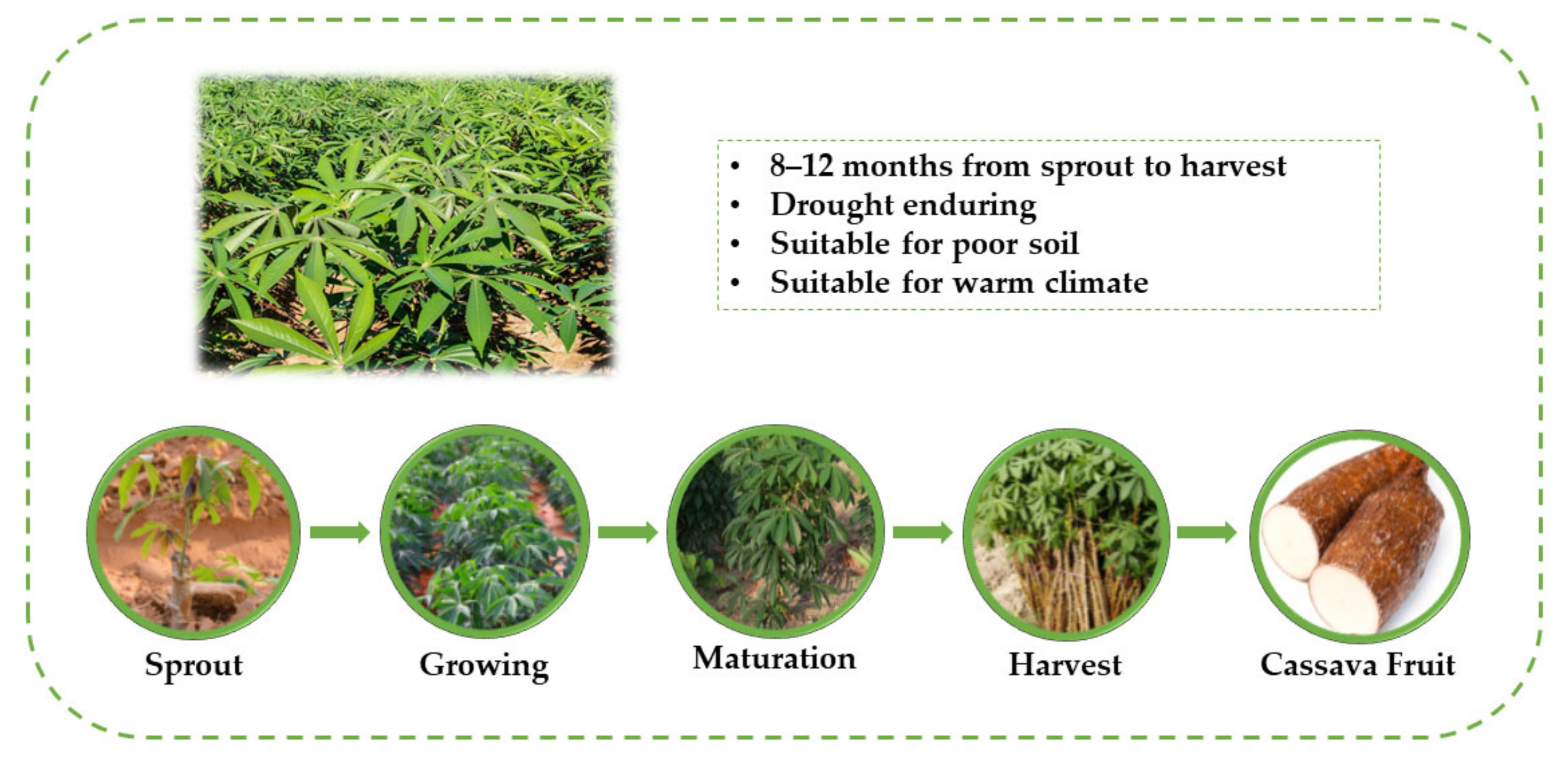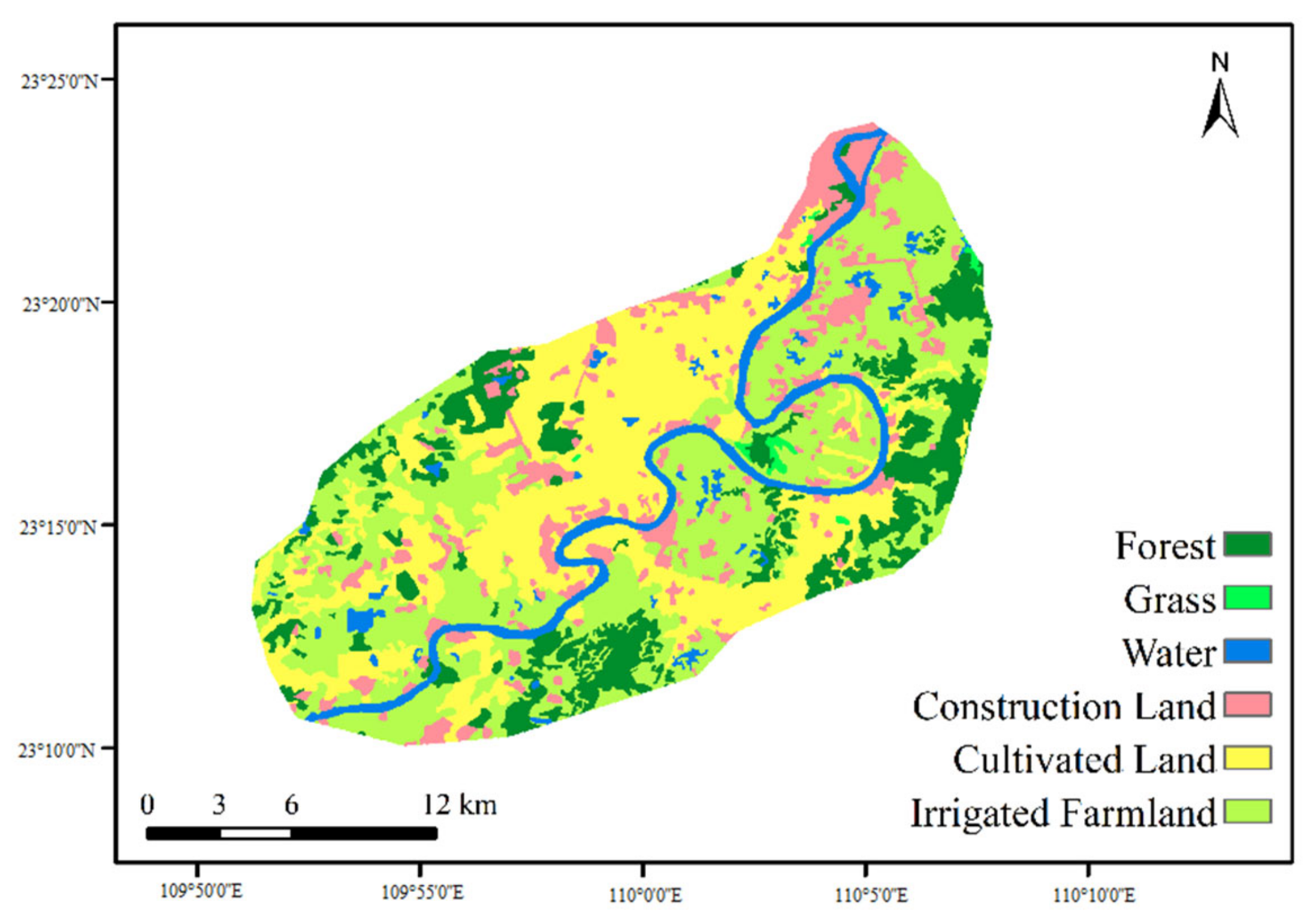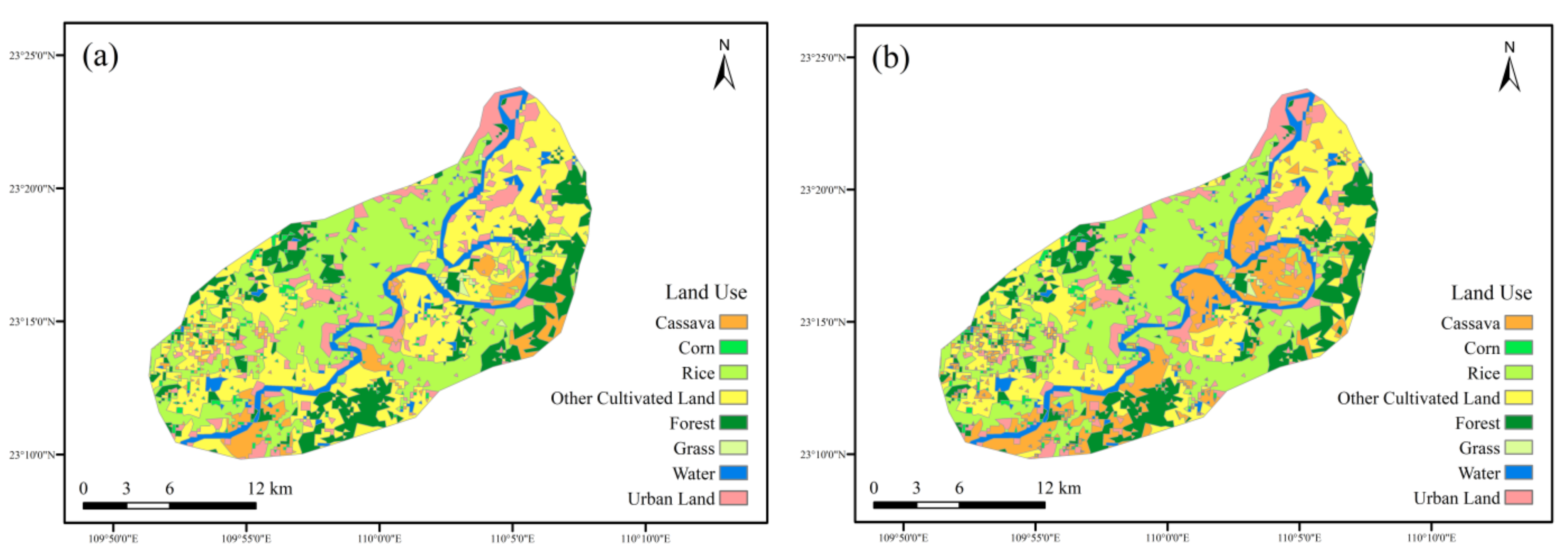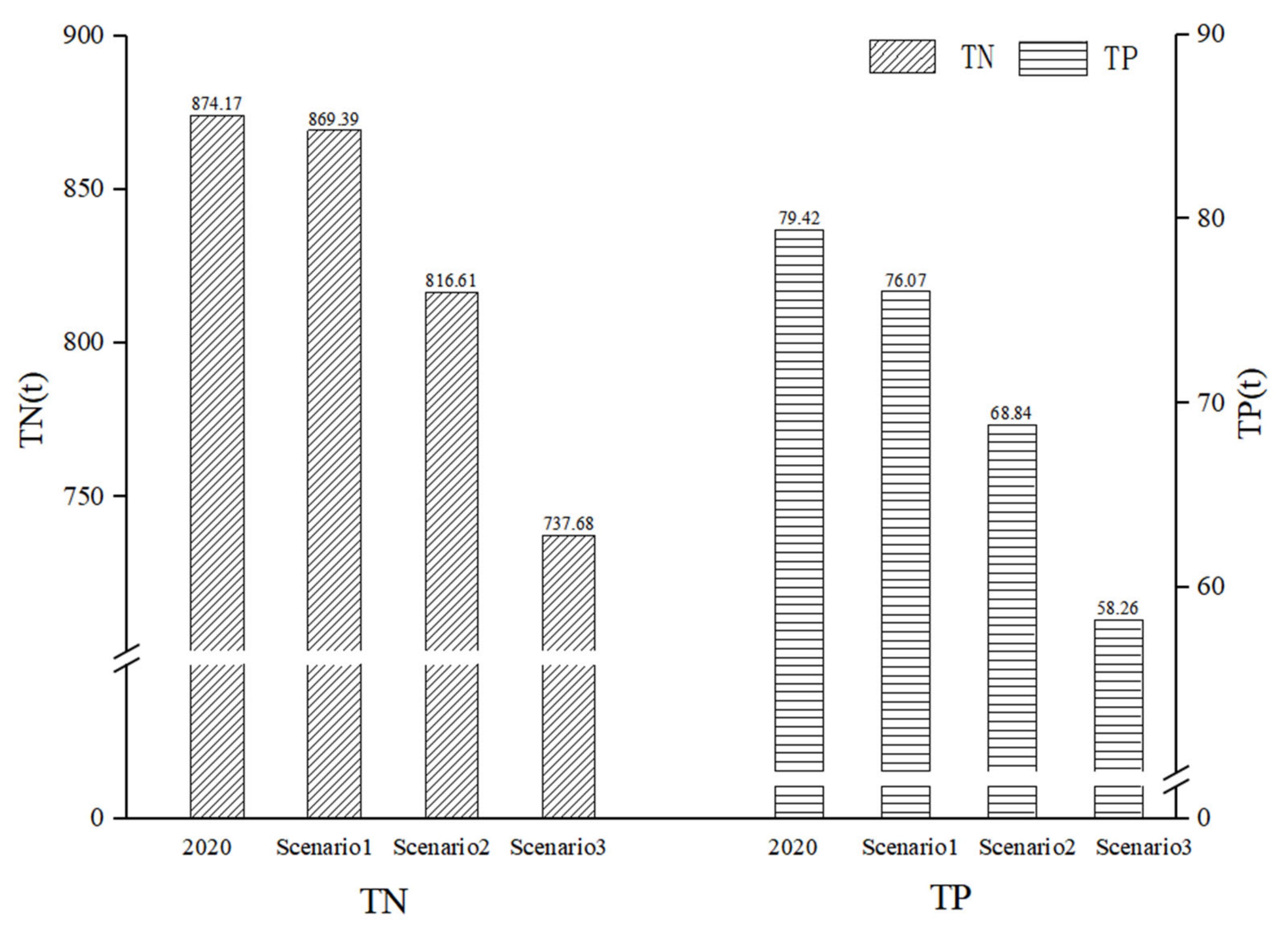Mechanism of Response of Watershed Water Quality to Agriculture Land-Use Changes in a Typical Fuel Ethanol Raw Material Planting Area—A Case Study on Guangxi Province, China
Abstract
:1. Introduction
- (1)
- Land-use transformation patterns were revealed through the interpretation of remote sensing images for two terms.
- (2)
- A nonpoint source pollution model was established after calibration and verification by a MIKE-SHE distributed hydrological model (Danish Hydraulic Institute, DHI, Copenhagen, Denmark). The influence of land-use changes on nonpoint source pollution in the watershed was obtained by multiple linear regression.
- (3)
- A scenario hypothesis of ethanol crop cultivation was set up based on the results of step two, in order to guide the spatial layout of land-use planning in the fuel ethanol planting area.
2. Materials and Methods
2.1. Overview of the Study Area
2.2. Interpretation of Land Use
2.3. Hydrological Model Construction
3. Results and Discussion
3.1. Land-Use Interpretation Results
3.2. Response Mechanism of Water Hydrology and Quality to Land-Use Changes
3.2.1. Water Hydrology and Quality Simulation
3.2.2. Impact of Land-Use Changes on TN and TP Load
3.3. Land-Use Scenario Assumptions in the Yujiang River Basin
- (1)
- Scenario One: According to the results of a previous loss risk assessment of the Yujiang River Basin, the intersection of high-risk loss areas of nitrogen as well as phosphorus and other cultivated land was set to be converted into a cassava area.
- (2)
- Scenario Two: The intersection of medium- and high-risk loss areas of nitrogen as well as phosphorus and other cultivated land was set to be converted into a cassava area.
- (3)
- Scenario Three: The cassava area continuously increased until the profit of other cultivated land (sugarcane and vegetables) was replaced by the cassava benefit difference. According to the economic data obtained in 2020, the upper limit for the cassava area was 126.0 km2. The area of corn and rice would remain unchanged to ensure food security.
4. Conclusions
- (1)
- The main land-use type in the Yujiang River Basin was other cultivated land, while the area of cassava is increasing. From the land-use transition matrix, the conversion between cassava and other cultivated land was the easiest, which gave a case principle for the scenario’s assumption setting.
- (2)
- The increase in cultivated land and construction land would lead to a rise in the load of TN and TP, while an expansion of forest land and grassland area would reduce TN and TP load in the watershed. As for the crop structures, corn would have a significant positive impact on TN and TP, while rice and cassava would not have a striking impact.
- (3)
- The increase in the cassava area in the Yujiang River Basin was beneficial to reduce nonpoint source pollution. The maximum increase in the area of cassava should be 126 km2. If it continues to rise past that level, it could cause negative impacts on farmers’ income and economic benefits.
Author Contributions
Funding
Institutional Review Board Statement
Informed Consent Statement
Data Availability Statement
Conflicts of Interest
References
- International Energy Agency. World Energy Outlook 2018; International Energy Agency: Paris, France, 2018; pp. 1–666. [Google Scholar]
- Sharma, S.; Kundu, A.; Basu, S.; Shetti, N.P.; Aminabhavi, T.M. Sustainable environmental management and related biofuel technologies. J. Environ. Manag. 2020, 273, 111096. [Google Scholar] [CrossRef]
- European Commission. Sustainable Transport|Mobility and Transport. Available online: https://ec.europa.eu/transport/themes/sustainable_en (accessed on 11 February 2021).
- Richard, C.J.; Josep, M.M.S.; Jordi, G.; Laureano, J.; Carlos, P. Comparing biofuels through the lens of sustainability: A data envelopment analysis approach. Appl. Energy. 2022, 307, 118201. [Google Scholar] [CrossRef]
- Mahmood, E.; Susan, V.D.; James, D.M.; Jack, S. Biofuels policies that have encouraged their production and use: An international perspective. Energy Policy 2020, 147, 111906. [Google Scholar] [CrossRef]
- Teklit, G.A.; Mentore, V.; Adrián, B.P.; Shiv, P.; Eric, D.V.H.; Sami, R.J. Emerging technologies for biofuel production: A critical review on recent progress, challenges and perspectives. J. Environ. Manag. 2021, 290, 112627. [Google Scholar] [CrossRef]
- Cameron, H.; Qi, Y.; Nicholas, S.; Bob, W.; Xie, C.; Dimitri, Z. Towards carbon neutrality and China’s 14th Five–Year Plan: Clean energy transition, sustainable urban development, and investment priorities. Environ. Sci. Technol. 2021, 8, 100130. [Google Scholar] [CrossRef]
- Austin, K.G.; Jones, J.P.H.; Clark, C.M. A review of domestic land use change attributable to U.S. biofuel policy. Renew. Sustain. Energy Rev. 2022, 159, 112181. [Google Scholar] [CrossRef]
- Fadhil, K.J.; Katherine, G. Statistical assessment of nonpoint source pollution in agricultural watersheds in the Lower Grand River watershed, MO, USA. Environ. Sci. Pollut. Res. 2019, 26, 1487–1506. [Google Scholar] [CrossRef] [Green Version]
- Cui, G.; Wang, X.; Li, C.; Li, Y.; Yan, S.; Yang, Z. Water use efficiency and TN/TP concentrations as indicators for watershed land-use management: A case study in Miyun District, north China. Ecol. Indic. 2018, 92, 239–253. [Google Scholar] [CrossRef]
- Yan, S.; Wang, X.; Cai, Y.; Li, C.; Yan, R.; Cui, G.; Yang, Z. An Integrated Investigation of Spatiotemporal Habitat Quality Dynamics and Driving Forces in the Upper Basin of Miyun Reservoir, North China. Sustainability 2018, 10, 4625. [Google Scholar] [CrossRef] [Green Version]
- Xu, Y.; Wang, X.; Bai, J.; Wang, D.; Wang, W.; Guan, Y. Estimating the Spatial Distribution of Soil Total Nitrogen and Available Potassium in Coastal Wetland Soils in the Yellow River Delta by Incorporating Multi-Source Data. Ecol. Indic 2020, 111, 106002. [Google Scholar] [CrossRef]
- Moriken, C.; Nor, R.J.; Ahmad, F.B.A. Impact of land uses on water quality in Malaysia: A review. Ecol. Process. 2019, 8, 10. [Google Scholar] [CrossRef]
- Ni, X.; Parajuli, P.B.; Ouyang, Y.; Dash, P.; Siegert, C. Assessing land use change impact on stream discharge and stream water quality in an agricultural watershed. CATENA 2021, 198, 105055. [Google Scholar] [CrossRef]
- Chen, Y.; Ale, S.; Rajan, N.; Srinivasan, R. Modeling the effects of land use change from cotton (Gossypium hirsutum L.) to perennial bioenergy grasses on watershed hydrology and water quality under changing climate. Agric. Water Manag. 2017, 192, 198–208. [Google Scholar] [CrossRef]
- Rebecca, L.R.; Nathaniel, R.S.; Gail, T. Identifying potential environmental impacts of large–scale deployment of dedicated bioenergy crops in the UK. Renew. Sust. Energ. Rev. 2009, 13, 271–290. [Google Scholar] [CrossRef]
- Liu, Y.; Cui, G.; Bai, X.; Yu, Z.; Dong, L. Characteristics and source apportionment of nitrogen and phosphorus non-point source pollution in Wuming River Basin, Guangxi. J. China Environ. Sci. 2021, 41, 2821–2830. Available online: https://kns.cnki.net/kcms/detail/detail.aspx?FileName=ZGHJ202106041&DbName=CJFQ2021 (accessed on 1 March 2022).
- Roy, R.G.; Mahesh, K.S.; Manoj, K.J. Simulating the impacts of bio–fuel crop production on nonpoint source pollution in the Upper Mississippi River Basin. Ecol. Eng. 2015, 74, 223–229. [Google Scholar] [CrossRef]
- Ouyang, W.; Hao, X.; Wang, L.; Xu, Y.; Mats, T.; Gao, X.; Lin, C. Watershed diffuse pollution dynamics and response to land development assessment with riverine sediments. Sci. Total Environ. 2019, 659, 283–292. [Google Scholar] [CrossRef]
- Nurul, S.M.A.; Kuan, S.K.; Kit, W.C.; Pau, L.S.; Chen, W.H.; Hong, P.N. Sustainability of the four generations of biofuels—A review. Int. J. Energy Res. 2020, 44, 9266–9282. [Google Scholar] [CrossRef]
- Zhang, Z.; Li, G.; Zhang, Y.; Zhang, J.; Song, C.; Zhou, Y. Recommendations for green development of motor biofuel industry in China: A review. Int. J. Agric. Biol. Eng. 2020, 13, 218–225. [Google Scholar] [CrossRef]
- Boly, M.; Sanou, A. Biofuels and food security: Evidence from Indonesia and Mexico. Energy Policy 2022, 163, 112834. [Google Scholar] [CrossRef]
- Azhaham, P.S.; Arivalagan, P.; Thangavel, M. A comprehensive assessment of biofuel policies in the BRICS nations: Implementation, blending target and gaps. Fuel 2020, 272, 117635. [Google Scholar] [CrossRef]
- Chantima, R.; Seksan, P.; Ruethai, O.; Benjamaporn, T. Evaluation of the environmental performance of bioethanol from cassava pulp using life cycle assessment. J. Clean. Prod. 2021, 284, 124741. [Google Scholar] [CrossRef]
- Enesi, R.; Hauser, S.; Pypers, P.; Kreye, C.; Tariku, M.; Six, J. Understanding changes in cassava root dry matter yield by different planting dates, crop ages at harvest, fertilizer application and varieties. Eur. J. Agron. 2022, 133, 126448. [Google Scholar] [CrossRef]
- Donkor, E.; Onakuse, S.; Bogue, J.; Bogue, J.; Carmenado, I.D. The impact of the presidential cassava initiative on cassava productivity in Nigeria: Implication for sustainable food supply and food security. Cogent. Food Agric. 2017, 3, 1368857. [Google Scholar] [CrossRef]
- Visses, F.; Sentelhas, P.C.; Pereira, A.B. Yield gap of cassava crop as a measure of food security—An example for the main Brazilian producing regions. Food Secur. 2018, 10, 1191–1202. [Google Scholar] [CrossRef]
- Jakrawatana, N.; Pingmuangleka, P.; Gheewala, S.H. Material flow management and cleaner production of cassava processing for future food, feed and fuel in Thailand. J. Clean. Prod. 2016, 134, 633–641. [Google Scholar] [CrossRef]
- Luo, C.; Yang, L.; Ou, Z.; Luo, Y. Current Situation and Prospects of Cassava Food Processing. J. Acta Agric. Jiangxi 2019, 31, 107–112. Available online: https://kns.cnki.net/kcms/detail/detail.aspx?FileName=JXNY201903020&DbName=CJFQ2019 (accessed on 2 March 2022).
- Hao, M.; Jiang, D.; Wang, J.; Fu, J.; Huang, Y. Could biofuel development stress China’s water resources. GCB Bioenergy 2017, 9, 1447–1460. [Google Scholar] [CrossRef]
- Li, H.Z.; Zhang, M.X. A review on the calculation of non—Point source pollution loads. IOP Conf. Ser. Environ. Earth Sci. 2019, 344, 12138. [Google Scholar] [CrossRef]
- Hong, H.N.; Friedrich, R.; Wayne, M.; Jacqueline, F.; He, Y.; Matthew, S.G. Comparison of the alternative models SOURCE and SWAT for predicting catchment streamflow, sediment and nutrient loads under the effect of land use changes. Sci. Total Environ. 2019, 662, 254–265. [Google Scholar] [CrossRef]
- Yasarer, L.M.W.; Lohani, S.; Bingner, R.L.; Locke, M.A.; Baffaut, C.; Thompson, A.L. Assessment of the Soil Vulnerability Index and comparison with AnnAGNPS in two Lower Mississippi River Basin watersheds. J. Soil Water Conserv. 2019, 75, 53–61. [Google Scholar] [CrossRef] [Green Version]
- Liu, S.; Liu, H.; Wang, L. Research on the development and application of Mike she model. J. China Hydrol. 2018, 38, 23–28. Available online: https://kns.cnki.net/kcms/detail/detail.aspx?FileName=SWZZ201805005&DbName=CJFQ2018 (accessed on 2 March 2022).
- Thanh, T.N.; Ingrid, K.; Patrick, W. Conceptual river water quality model with flexible model structure. Environ. Model. Softw. 2018, 104, 102–117. [Google Scholar] [CrossRef]
- Sun, C.; Chen, L.; Zhai, L.; Liu, H.; Wang, K.; Jiao, C.; Shen, Z. National assessment of nitrogen fertilizers fate and related environmental impacts of multiple pathways in China. J. Clean. Prod. 2020, 277, 123519. [Google Scholar] [CrossRef]
- Huang, J.; Xu, C.; Ridoutt, B.G.; Wang, X.; Ren, P. Nitrogen and phosphorus losses and eutrophication potential associated with fertilizer application to cropland in China. J. Clean. Prod. 2017, 159, 171–179. [Google Scholar] [CrossRef]
- Pypers, P.; Bimponda, W.; Lodi, L.; Jean, P.; Lele, B.; Mulumba, R.; Kachaka, C.; Boeckx, P.; Merckx, R.; Vanlauwe, B. Combining Mineral Fertilizer and Green Manure for Increased, Profitable Cassava Production. Agron. J. 2012, 104, 178–187. [Google Scholar] [CrossRef]
- Jiang, J.; Li, J.; Wang, Z.; Wu, X.; Lai, C.; Chen, X. Effects of different cropping systems on ammonia nitrogen load in a typical agricultural watershed of South China. J. Contam. Hydrol. 2022, 246, 103963. [Google Scholar] [CrossRef]
- Adiele, J.G.; Schut, A.G.T.; van den Beuken, R.P.M.; Ezui, K.S.; Pypers, P.; Ano, A.O.; Egesi, C.N.; Giller, K.E. Towards closing cassava yield gap in West Africa: Agronomic efficiency and storage root yield responses to NPK fertilizers. Field Crops Res. 2020, 253, 107820. [Google Scholar] [CrossRef]
- Howeler, R.H. Cassava: Biology, Production and Utilization; CABI: Bangkok, Thailand, 2002; pp. 115–148. Available online: https://www.cabi.org/cabebooks/ebook/20073012660 (accessed on 18 April 2022).
- Li, Z. Evaluation of Water Pollution Control Measures in Yanghe Basin Based on MIKE SHE Model. Master’s Thesis, Hubei University of Technology, Hubei, China, 2020. Available online: https://kns.cnki.net/kcms/detail/detail.aspx?FileName=1021522567.nh&DbName=CMFD2021 (accessed on 21 April 2022).
- Hao, H.; Liu, Z.; Zhao, F.; Ren, J.; Chang, S.; Rong, K.; Du, J. Biofuel for vehicle use in China: Current status, future potential and policy implications. Renew. Sust. Energ. Rev. 2018, 82, 645–653. [Google Scholar] [CrossRef]
- Ding, H.; Ali, A.; Cheng, Z. Dynamics of a Soil Fungal Community in a Three-Year Green Garlic/Cucumber Crop Rotation System in Northwest China. Sustainability 2018, 10, 1391. [Google Scholar] [CrossRef] [Green Version]
- Silva, D.V.; Ferreira, E.A.; Oliveira, M.C.; Pereira, G.A.M.; Braga, R.R.; Santos, J.D.; Aspiazu, I.; Souza, M.F. Productívíty of cassava and other crops in an intercropping system. Cienc. Investig. Agrar. 2016, 43, 159–166. [Google Scholar] [CrossRef] [Green Version]









| Data Types | Name | Data Source |
|---|---|---|
| Geographical data | DEM elevation data | GS Cloud |
| Hydrological data | River network River section Discharge Water level TN and TP concentration | Hydrology Center of Guangxi Zhuangzu Autonomous Region (http://swzx.gxzf.gov.cn/) (accessed on 10 October 2021) |
| Water quality data | Fertilizer | 2020 National Agricultural Product Cost-benefit Data Corpus (https://www.yearbookchina.com/navibooklist-n3020013195-1.html) (accessed on 1 September 2021) |
| Meteorological data | Precipitation Reference evapotranspiration | National Meteorological Science Data Center (http://data.cma.cn/) (accessed on 15 September 2021) |
| Vegetation | Leaf area index Root depth | The literature surveys FAO (https://www.fao.org/land–water/databases–and–software/crop–information/en/) (accessed on 15 October 2021) |
| Soil properties | Surface and sectional type | Harmonized World Soil Database |
| Type | Cassava | Corn | Rice | Other Cultivated Land | Forest | Grass | Water | Urban Land | |
|---|---|---|---|---|---|---|---|---|---|
| 2015 | Area/km2 | 5.6 | 12.3 | 121.1 | 138.8 | 56.7 | 1.7 | 25.5 | 45.1 |
| Percentage | 1.4% | 3.0% | 29.8% | 34.1% | 13.9% | 0.4% | 6.3% | 11.1% | |
| 2020 | Area/km2 | 6.1 | 6.7 | 121.5 | 142.1 | 58.1 | 1.7 | 26.7 | 43.9 |
| Percentage | 1.5% | 1.7% | 29.9% | 34.9% | 14.3% | 0.4% | 6.6% | 10.8% | |
| 2015 2020 | Cassava | Corn | Rice | Other Cultivated Land | Forest | Grass | Water | Urban Land |
|---|---|---|---|---|---|---|---|---|
| Cassava | 2.3 | 0.7 | 0.7 | 2.0 | 0.2 | 0.0 | 0.1 | 0.1 |
| Corn | 0.5 | 1.5 | 5.2 | 6.7 | 1.4 | 0.0 | 0.3 | 0.6 |
| Rice | 1.1 | 2.0 | 113.0 | 0.0 | 0.0 | 0.0 | 0.0 | 0.0 |
| Other Cultivated Land | 1.8 | 2.6 | 0.0 | 130.1 | 0.0 | 0.0 | 0.0 | 0.0 |
| Forest | 0.3 | 0.9 | 0.0 | 0.0 | 56.5 | 0.0 | 0.0 | 0.0 |
| Grass | 0.0 | 0.0 | 0.0 | 0.0 | 0.0 | 1.9 | 0.0 | 0.0 |
| Water | 0.1 | 0.1 | 0.0 | 0.0 | 0.0 | 0.0 | 27.1 | 0.0 |
| Urban Land | 0.2 | 0.2 | 0.0 | 0.0 | 0.0 | 0.0 | 0.0 | 45.3 |
| Cultivated Land | Forest | Grass | River | Urban Land | |
|---|---|---|---|---|---|
| TN | 0.978 ** | −0.945 ** | −0.881 ** | 0.185 | 0.901 ** |
| TP | 0.939 ** | −0.889 ** | −0.798 ** | 0.078 | 0.912 ** |
| Corn | Rice | Cassava | Other Cultivated Land | |
|---|---|---|---|---|
| TN | 0.795 * | 0.504 | –0.351 | 0.851 ** |
| TP | 0.826** | 0.318 | –0.353 | 0.936 ** |
| TN | TP | |||
|---|---|---|---|---|
| B | p | B | p | |
| Cassava | 4.699 | 0.097 | 0.108 | 0.307 |
| Corn | 3.349 * | 0.030 * | 0.180 | 0.017 * |
| Rice | 2.712 | 0.099 | 0.072 | 0.226 |
| Other cultivated land | 3.659 ** | 0.009 ** | 0.262 | 0.012 * |
| R2 | 0.967 | 0.985 | ||
| F | F = 29.606, p = 0.003 | F = 63.791, p = 0.001 | ||
| Types | 2020 | Scenario One | Scenario Two | Scenario Three | |||
|---|---|---|---|---|---|---|---|
| Area | Area | Change | Area | Change | Area | Change | |
| Cassava | 6.1 | 25.0 | +308% | 66.0 | +978% | 126.0 | +1958% |
| Corn | 6.7 | 6.7 | 0% | 6.7 | 0% | 6.7 | 0% |
| Rice | 121.5 | 121.5 | 0% | 121.5 | 0% | 121.5 | 0% |
| Other cultivated land | 142.1 | 123.2 | −13% | 82.2 | −42% | 22.2 | −84% |
| Forest | 58.1 | 58.1 | 0% | 58.1 | 0% | 58.1 | 0% |
| Grass | 1.7 | 1.7 | 0% | 1.7 | 0% | 1.7 | 0% |
| Water | 26.7 | 26.7 | 0% | 26.7 | 0% | 26.7 | 0% |
| Urban land | 43.9 | 43.9 | 0% | 43.9 | 0% | 43.9 | 0% |
Publisher’s Note: MDPI stays neutral with regard to jurisdictional claims in published maps and institutional affiliations. |
© 2022 by the authors. Licensee MDPI, Basel, Switzerland. This article is an open access article distributed under the terms and conditions of the Creative Commons Attribution (CC BY) license (https://creativecommons.org/licenses/by/4.0/).
Share and Cite
Cui, G.; Bai, X.; Wang, P.; Wang, H.; Wang, S.; Dong, L. Mechanism of Response of Watershed Water Quality to Agriculture Land-Use Changes in a Typical Fuel Ethanol Raw Material Planting Area—A Case Study on Guangxi Province, China. Int. J. Environ. Res. Public Health 2022, 19, 6499. https://doi.org/10.3390/ijerph19116499
Cui G, Bai X, Wang P, Wang H, Wang S, Dong L. Mechanism of Response of Watershed Water Quality to Agriculture Land-Use Changes in a Typical Fuel Ethanol Raw Material Planting Area—A Case Study on Guangxi Province, China. International Journal of Environmental Research and Public Health. 2022; 19(11):6499. https://doi.org/10.3390/ijerph19116499
Chicago/Turabian StyleCui, Guannan, Xinyu Bai, Pengfei Wang, Haitao Wang, Shiyu Wang, and Liming Dong. 2022. "Mechanism of Response of Watershed Water Quality to Agriculture Land-Use Changes in a Typical Fuel Ethanol Raw Material Planting Area—A Case Study on Guangxi Province, China" International Journal of Environmental Research and Public Health 19, no. 11: 6499. https://doi.org/10.3390/ijerph19116499
APA StyleCui, G., Bai, X., Wang, P., Wang, H., Wang, S., & Dong, L. (2022). Mechanism of Response of Watershed Water Quality to Agriculture Land-Use Changes in a Typical Fuel Ethanol Raw Material Planting Area—A Case Study on Guangxi Province, China. International Journal of Environmental Research and Public Health, 19(11), 6499. https://doi.org/10.3390/ijerph19116499





